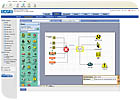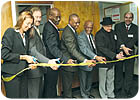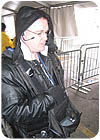Policy-based Systems: Follow the Rules

Thanks in large part to digital security video and intelligent software platforms, a primary trend, especially for top multinational enterprises, is to centralize global corporate physical security and integrate it with other business systems and controls.
Practically all facility-based physical security systems, devices and services have operated in silos that are very loosely connected with each other, observed Ajay Jain, president and CEO of Quantum Secure, San Jose, Calif. No doubt, obtaining a comprehensive view of physical security operations for all corporate locations worldwide is very challenging. But according to Jain, “the problem further gets exasperated with localized security processes, ad-hoc event handling, countless alarms and lack of holistic reporting from multi-vendor proprietary systems. Moreover, data sets originating from these locations are flat and disjointed. For example, alarm IDs, door names, access levels, card formats, spatial hierarchy and surveillance camera configurations are often represented differently in each facility.”
What’s now emerging are enterprise class applications that centrally manage and orchestrate corporate security based on business policies and rules.
Convergence gurus such as Steve Hunt of 4A International (See his column elsewhere in this issue.) agree. “Once you think your job is security, you are doomed,” Hunt contends. “Our job is to secure the business.” By solving business problems, security works itself out, Hunt added.
Known more formally as policy-based physical security management, new-age applications, an example is SAFE from Quantum Secure, let security managers define, document, deploy and enforce physical security policies across multiple system platforms, technologies and facility sites. This enables corporations to implement business best practices globally and reduce operational cost by providing end-to-end management of complex physical security infrastructures from a single Web console.
A new tool
One of the driving forces for the genesis of policy-based physical security management software is the fact that security systems (and security professionals) are swimming in pools of disparate information, according to Jain. Moreover, data sets originating from physical security systems and infrastructure are flat and disjointed without much contextual information. As a result, many security practices have evolved in response to specific situations and exposures and, as circumstances change over time, many of these practices become outdated and inefficient.Furthermore, changes and modifications that are implemented are often added on top of existing processes rather than addressing fundamental architectures and systems, leading to a cobbled together collection of overly specific rules, numerous exceptions and lax controls.
By taking a page from core business processes such as manufacturing, accounting and logistics that have been normalized across numerous boundaries, policy-based security management does the same for security video, access controls and intrusion detection. It integrates information from disparate sources; it applies correlations and other statistical analysis to highlight unusual situations; and it automatically coordinates appropriate responses and actions. Enterprise security executives can then centrally deploy “business rules” so that security and various of its systems conform to consistent corporate policies.
As Quantum Secure’s Jain explained it, a security policy defined in the policy-based system will automatically alert appropriate security teams and take necessary coordinative actions if FEMA declares a flood warning near a corporate warehouse or pre-defined policies will automatically detect and resolve a cluster of false alarms generated by a video camera malfunction.
Security Magazine research has identified policies as one of the pillars of the traditional security operation.
Policy-based security management completes the circle.
Integration of system platforms
Added Jain, “It is not unusual for physical and IT security systems to create challenges for each other because each is trying to optimize their individual domain and shift costs to other functions. Because these systems are typically disjointed from each other with different product architectures and vendors, rivalries and inefficiencies often create huge security gaps and risk exposure for the overall enterprise. The good news is that these problems can be alleviated through the implementation of an enterprise-wide physical security policy solution.”
Side bar: TiVo Era for Security
A new era of security video has arrived, according to Al Simon, president of Nortronics Corp., a New York-area security integrator. He recently told a group of public officials, security equipment manufacturers, property managers, architects, security personnel and residents that the “TiVo Era” of security has finally arrived for New York City apartment buildings.The event – ribbon cutting at 1199 Plaza/East River Landing in Upper Manhattan, where Nortronics unveiled the most advanced security system in place at a New York residential complex. Keith Spadaro, deputy commissioner of the New York City Office of Emergency Management, was there to learn more about the sophisticated technology and how it can better protect New York’s apartment dwellers.

Side bar: Super Bowl Security Rules, Too
Unique 3D security video and sensor fusion technology were part of the mix at the recent Super Bowl, an event that gets heightened sensitivity by the U.S. Homeland Security Department. Homeland Security and the National Football League that set the rules.Intrepid Defense & Security Systems, a Birmingham, Mich.-based company specializing in high resolution 3D visualization, worked with JC Hanlon Consulting, to provide enhanced capability in weapons detection, tunnel and bridge border surveillance, and facility monitoring.
And, for the first time, Super Bowl XL deployed new sensor fusion technology that greatly increased the safety of the 65,000 fans gathered at Ford Field in Detroit, Michigan. Members of the Michigan National Guard patrolled the football stadium equipped with small computers containing sensing devices that connected to a wireless network.
When traces of foreign substances were detected on some Super Bowl attendees, the new wireless network enabled every member of the security force to know, in real time, which element and isotope were present and where. In each case attendees were approached and the substances were identified as non-hazardous materials.
“In past years, security personnel have walked around Super Bowls and reported in regularly by radio,” said Jeffrey Ricker, CEO of Distributed Instruments. This Sterling Heights, Michigan-based company developed and supplied the software and servers that enable the sensor fusion system to integrate all data in real time. “This year the handheld computers carried by members of the Michigan National Guard instantly communicated any suspected materials to all connected security personnel.”
The sensor connections and data streaming are achieved through Transducer Data Exchange Protocol. TDXP makes it possible for each security member to see his location and the location of all other sensors. When a sensor reading crosses a threshold level, an alert is broadcast so that decision makers at the command center can decide and communicate the actions to take immediately.
In addition to being part of hand-held computers, the sensor fusion technology used at Super Bowl XL can be employed in fixed positions along borders of countries or perimeters of property, and it can be mounted on vehicles. It can monitor large groups of people or function well in isolated areas. The data points it collects from dozens, hundreds or even thousands of sensors, are then processed into a single merged set of data and transmitted wirelessly through a network to stationary or mobile command centers for real-time decisions and action.
“At Super Bowl XL, we did updates to the system on the fly,” said Paul Lyman, president of Distributed Instruments.

Side bar: Healthcare Security Embraces Policy-based Systems
In an era of managed care, specialized medicine, mile-high paperwork, high costs, identity fraud and government demand for secure, portable and confidential patient information, the competitiveness of healthcare providers depends on the proper use of information technology. As a result, the healthcare industry is on the cusp of a move away from error-prone paper and ink toward a more secure electronic world.A new white paper, Smart Card Applications in the U.S. Healthcare Industry, examines how smart card technology is being incorporated into new healthcare systems to protect and enable convenient access to patient data and support new applications that deliver clinical and administrative benefits. It’s from the Smart Card Alliance.
The white paper includes profiles of a number of organizations who are implementing smart cards, including the Queens Health Network, University of Pittsburgh Medical Center, St. Luke’s Episcopal Health System, Florida eLife-Card, Texas Medicaid, and the French and German health cards. Information is at www.smartcardalliance.org.
Links
Looking for a reprint of this article?
From high-res PDFs to custom plaques, order your copy today!








